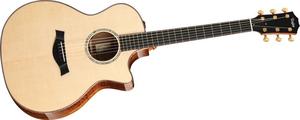Taylor 714ce Guitar
![]()
![]()
![]()
![]()
![]()
![]()
![]()
![]()

Taylor makes some of the sweetest acoustic guitars in the known universe, and this is one of them. In fact, it’s two of them – this is my second 714ce. My first one, built in 1998, is still playing, subject only to some fret replacements a few months ago. I bought a second 714ce to have access to Taylor’s estimable Expression pickup system, a feature that didn’t exist back at the end of the twentieth century.
My new 714ce is a limited edition instrument, with a spruce top, rather than the red cedar top that the 714ce is usually built with, and Madagascar rosewood back and sides, rather than Indian rosewood. The spruce top makes it just detectably brighter than my original 714ce, and the Madagascar rosewood seems to be wholly cosmetic – although it must be said that it looks cool.
As with all the high-end Taylors I’ve played, the 714ce is built with flawless craftsmanship implementing a simple, elegant design. It includes sufficient inlay to be attractive, but not enough to look like it belongs in a Nevada bordello, a lamentable failing of some high-end instruments. Its wooden elements have clearly been carefully selected, and they exhibit the unique beauty of exotic tone woods with none of the imperfections of machine-made guitars.
As an aside, if you prefer lots of inlay or if you decorate Nevada bordellos for a living and you resented the reference thereto in the foregoing paragraph, the Taylor 814ce and 914ce instruments play very much like this one, with progressively more bling.
The 714ce is what Taylor calls a “grand auditorium” size guitar. It’s considerably smaller than a conventional dreadnaught, but it has an unmistakable voice. It projects remarkably well for a smaller guitar, and it’s comfortable to play.
With a straight, quick neck, a light action and perfectly adjusted frets, the 714ce very nearly plays itself. It’s remarkably quick and responsive. As with many high-end, hand made instruments, the Taylor 714ce feels a bit like buying talent. Its virtuosity seems to make anyone who plays one a better musician.
One of the most notable tonal qualities of the 714ce is the precision of its sound. It lacks the booming, echo-chamber reverberation of a full-size dreadnaught, and every note played on it is distinct and perfect. It’s an ideal axe for finger-style playing.
At about three thousand dollars when it hits the street, the 714ce is a very modestly-priced hand made instrument. Taylor’s approach to building guitars differs from that of traditional instrument builders, in that the hands that make them don’t do all the work. Taylor uses computer aided manufacturing technology to perform much of the heavy lifting in building its guitars, and then talented luthiers to assemble them.
The 714ce ships with Elixir Nanoweb resin-coated strings, which seem to suit it impeccably. They’re what I’d regard as refined and some guitarists would probably call “dead,” without the twang and string noise of most coated strings. If you decide you like them, they’re easily available, unlike traditional factory mystery-strings.
This having been said, they seem to last forever.
Playing the Taylor 714ce is an exercise in self-indulgence. It’s all but impossible to put down, and everything played on it sounds new and intricate. It has a dark, centered presence that can usually make even your mistakes sound cool.
The Expression pickup system installed in contemporary Taylor guitars is singularly well engineered – and all the more remarkable when it’s compared to the almost universal disappointment of acoustic guitar transducers. It sounds like an acoustic microphone rather than a glued-in pickup, save that it’s impervious to any room noise less audible than a nearby earthquake, and it doesn’t require that you nail yourself to your chair to avoid going off mic. It actually consists of three transducers – two under the top and one under the fret board extension – connected to a battery-powered pre-amp. Its controls consist of three discrete plastic knobs and no flashing LEDs.
Aside from playing well, the Taylor 714ce clearly plays long. With twelve years on its clock, my first 714ce is every bit as articulate and impressive as the day I bought it. I expect this one to age as gracefully.
The 714ce comes in a custom-made Taylor hard-shell case with impressive internal padding and a lot of locks. It also comes with an unusual wealth of documentation to keep it playing, all of it worth reading. The page that discusses guitar case humidifiers and the remarkable range of issues they address should be the first thing you check out.
Possibly the last acoustic guitar I’ll ever want, the 714ce can really only be appreciated if you play one. This having been said, I don’t recommend doing so unless you have some headroom on your plastic, as it will be all but impossible to leave the store without the guitar.
On the day I went guitar shopping, I bought this Taylor 714ce and a Taylor GS Baritone guitar, a singular instrument which is reviewed in another posting. I did actually hear a distinct sucking sound coming from my credit card on the way out, but I ignored it. Some things are worth what they cost.
Finally, I was impressed with Taylor’s network of trained service technicians, in this case, at Cosmo Music north of Toronto. The refret on my older 714ce was impeccable – the technician actually ordered fret wire from Taylor to ensure that the new frets would match their existing cousins.